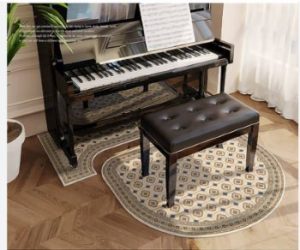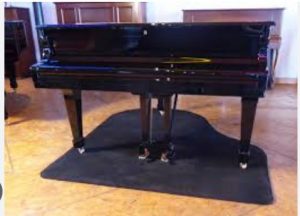If you’re about to embark on the challenging task of moving a piano on a carpet, you’ve come to the right place. As an expert mover, I’m here to give you the lowdown on the four critical things you need to know before you start rolling that piano.

Moving A Piano On Carpet
1. Use Proper Equipment.
Before you even think about nudging that piano an inch, make sure you have the right equipment. Heavy-duty furniture dollies or piano skids are a must.
These tools will help distribute the weight of the piano evenly and prevent damage to your floors. Never attempt to move a piano without the proper equipment.
2. Protect Your Floors.
Carpets can be a tricky surface to navigate when moving heavy objects like pianos. To avoid damaging your carpet or leaving unsightly marks, lay down thick blankets or plywood underneath the piano’s wheels or legs.
This will provide a smooth surface for the piano to glide over and protect your carpet from tears or indentations. Remember, a little bit of precaution goes a long way!
3. Get Some Help.
Moving a piano on carpet is not a one-person job; trust me on this one. Gather a team of helpers to assist you with the move. Make sure everyone knows their role and communicates effectively to avoid accidents.
Coordinate your movements carefully to ensure a smooth and safe transfer. And remember, there’s no shame in asking for help; it’s better to be safe than sorry!
4. Plan Your Route
Before you start moving the piano, plan your route carefully. Measure doorways, hallways, and any tight spaces to ensure the piano will fit through without any hiccups.
Clear the path of any obstacles or debris that could trip you up along the way. And don’t forget to take it slow; rushing through the move could result in damage to the piano or your floors.

Moving A Piano On Carpet
5. Mind Your Posture
Moving a heavy object like a piano can put a strain on your body if you’re not careful. Maintain proper posture by lifting with your legs, not your back.
Bend your knees and keep your back straight to avoid injury. And remember to take breaks if you start to feel tired; there’s no shame in pacing yourself to prevent accidents.
6. Secure The Lid.
If your piano has a lid, make sure it’s securely closed before you start moving. This will prevent the lid from flapping open and potentially causing damage to the piano or nearby objects.
You can use heavy-duty straps or bungee cords to keep the lid closed and secure during the move. Safety first, folks!
7. Watch Out For Stairs.
Moving a piano up or down stairs adds an extra layer of difficulty to the process. Exercise extreme caution when navigating stairs, and consider enlisting the help of professionals if you’re not confident in your ability to do it safely.
Use ramps or lifts to make the process easier, and always have someone spot you from behind to prevent accidents.
8. Inspect The Destination
Before you start moving the piano, inspect the destination to ensure it’s ready to receive the piano. Check for any uneven flooring or obstacles that could pose a problem during the move.
Once the piano is in place, take the time to adjust its position carefully to ensure its level and stability. A little extra attention to detail now can save you a lot of headaches later on…
9. Communicate Clearly.
Effective communication is key when moving a piano on carpet, especially in a team setting. Establish a clear plan before you begin and ensure everyone knows their role. Use simple and direct instructions to avoid any confusion or misunderstandings.
And don’t be afraid to speak up if something doesn’t seem right; it’s better to address issues upfront than to deal with problems later on.
10. Protect The Piano
While it’s essential to protect your floors during the move, don’t forget about protecting the piano itself. Wrap the piano in thick blankets or moving pads to prevent scratches or dents.
Secure the blankets with heavy-duty tape to keep them in place during the move. And if you’re moving the piano in a truck or van, use straps or tie-downs to keep it from shifting during transit.
11. Consider Professional Help.
Moving a piano is no small feat, and sometimes it’s best to leave it to the professionals. If you’re not confident in your ability to move the piano safely, consider hiring a professional moving company that specialises in piano moving.
They have the experience, equipment, and know-how to get the job done right, saving you time, stress, and potentially costly repairs.
12. Take Your Time
Moving a piano is not something you want to rush through. Take your time to plan and execute the move carefully. Rushing can lead to accidents, injuries, or damage to the piano or your property.
So slow down, breathe, and remember that it’s better to do it right than to do it quickly.
FAQs
Q: Can I move a piano on my own?
Moving a piano is a challenging task that often requires a team effort, especially when navigating carpeted floors. While it’s possible to move a piano on your own with the right equipment and technique, it’s generally safer and more efficient to enlist the help of others, especially for heavier pianos.
Q: How do I protect my carpet when moving a piano?
A: To protect your carpet during a piano move, it’s essential to use thick blankets or plywood underneath the piano’s wheels or legs. This helps distribute the weight evenly and prevents damage to the carpet.
Additionally, consider laying down a pathway of protective materials along the route to minimise friction and potential damage.
Q: How much does it cost to hire professionals to move a piano?
A: The cost of hiring professionals to move a piano can vary depending on factors such as the size and weight of the piano, the distance of the move, and any additional services required.
On average, professional piano moving services can range from $100 to $1,000 or more. It’s recommended to get quotes from multiple moving companies and compare services to find the best option for your needs.
Q: What should I do if I encounter obstacles during the move?
If you encounter obstacles such as tight spaces or narrow doorways during the move, it’s essential to remain calm and assess the situation carefully.
Consider alternative routes or strategies for manoeuvring the piano, such as removing doors or temporarily disassembling parts of the piano if necessary.
If you’re unsure how to proceed, don’t hesitate to seek advice from professionals or experienced movers.
No Comments
Be the first to start a conversation